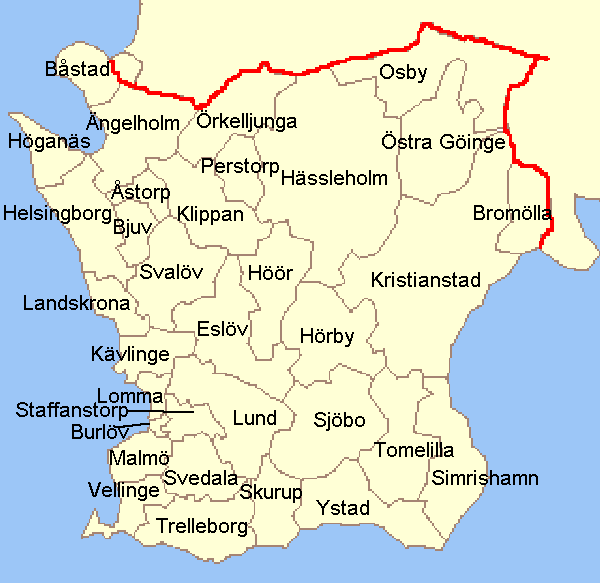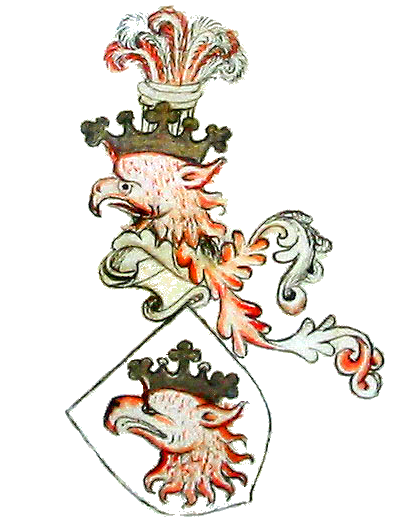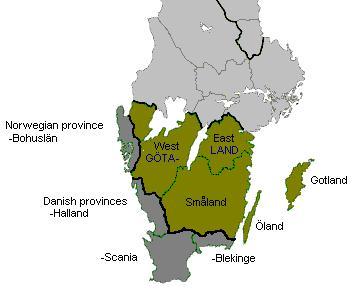|
Skåne
Scania, also known by its native name of Skåne (, ), is the southernmost of the historical provinces (''landskap'') of Sweden. Located in the south tip of the geographical region of Götaland, the province is roughly conterminous with Skåne County, created in 1997. Like the other former provinces of Sweden, Scania still features in colloquial speech and in cultural references, and can therefore not be regarded as an archaic concept. Within Scania there are 33 municipalities that are autonomous within the Skåne Regional Council. Scania's largest city, Malmö, is the third-largest city in Sweden, as well as the fifth-largest in Scandinavia. To the north, Scania borders the former provinces of Halland and Småland, to the northeast Blekinge, to the east and south the Baltic Sea, and to the west Öresund. Since 2000, a road and railway bridge, the Öresund Bridge, bridges the Sound and connects Scania with Denmark. Scania forms part of the transnational Øresund Region. From n ... [...More Info...] [...Related Items...] OR: [Wikipedia] [Google] [Baidu] |
Skåne County
Skåne County ( sv, Skåne län, link=no ), sometimes referred to as Scania County in English, is the most southern county, or , of Sweden, basically corresponding to the traditional province Scania. It borders the counties of Halland, Kronoberg and Blekinge and connects to Capital Region, Denmark by the Öresund Bridge. The seat of residence for the Skåne Governor is the city of Malmö. The headquarters of Skåne Regional Council are located in both Kristianstad and Malmö. The present county was created in 1997 when Kristianstad County and Malmöhus County were merged; it covers around 3% of Sweden's total area, while its population of 1.3 million comprises 13% of Sweden's total population. Prince Oscar is Duke of Skåne. Endonym and exonym When the new county was established in 1997, it was named ''Skåne län'' as its borders coincide with those of the province Skåne. In English, the county as well as the province are sometimes known as ''Scania'', but the name Skå ... [...More Info...] [...Related Items...] OR: [Wikipedia] [Google] [Baidu] |
Malmö
Malmö (, ; da, Malmø ) is the largest city in the Swedish county (län) of Scania (Skåne). It is the third-largest city in Sweden, after Stockholm and Gothenburg, and the sixth-largest city in the Nordic region, with a municipal population of 350,647 in 2021. The Malmö Metropolitan Region is home to over 700,000 people, and the Øresund Region, which includes Malmö and Copenhagen, is home to 4 million people. Malmö was one of the earliest and most industrialised towns in Scandinavia, but it struggled to adapt to post-industrialism. Since the 2000 completion of the Öresund Bridge, Malmö has undergone a major transformation, producing new architectural developments, supporting new biotech and IT companies, and attracting students through Malmö University and other higher education facilities. Over time, Malmö's demographics have changed and by the turn of the 2020s almost half the municipal population had a foreign background. The city contains many histori ... [...More Info...] [...Related Items...] OR: [Wikipedia] [Google] [Baidu] |
Scanian Dialects
Scanian ( sv, skånska , da, skånsk) is an East Scandinavian dialect spoken in the province of Scania in southern Sweden. Present-day speakers of "Scanian" speak the Scanian dialect of Swedish. Older Scanian formed part of the old Scandinavian dialect continuum and are by most historical linguists considered to be an East Danish dialect group, but due to the modern-era influence from Standard Swedish in the region and because traditional dialectology in the Scandinavian countries normally has not considered isoglosses that cut across state borders, the Scanian dialects have normally been treated as a South Swedish dialect group in Swedish dialect research. However, many of the early Scandinavian linguists, including Adolf Noreen and G. Sjöstedt, classified it as "South Scandinavian", and some linguists, such as Elias Wessén, also considered Old Scanian a separate language, classified apart from both Old Danish and Old Swedish. Status There has been active campaigning f ... [...More Info...] [...Related Items...] OR: [Wikipedia] [Google] [Baidu] |
Øresund Region
The Øresund Region ( da, Øresundsregionen ; sv, Öresundsregionen ), also known as Greater Copenhagen for marketing purposes, is a metropolitan region that comprises eastern Denmark and Skåne in southern Sweden. Centred around the Øresund strait and the two cities which lie on either side, Copenhagen in Denmark and Malmö in Sweden, the region is connected by the Øresund Bridge, which spans the strait at its southern end, and the HH Ferry route between Helsingør, Denmark, and Helsingborg, Sweden, at the narrowest point of the strait. The Capital Region of Denmark and Region Zealand constitute the Danish side, while Scania constitutes the Swedish side. The region has a population of 4,002,372 (2018) and a population density of . Since the Treaty of Roskilde of 1658, Scania ( sv, Skåne) has been subordinate to the King of Sweden, except during the Scanian War (1676–79) and briefly in 1710, but it only became a province of Sweden under the Treaty of Stockholm 1720 (dat ... [...More Info...] [...Related Items...] OR: [Wikipedia] [Google] [Baidu] |
Götaland
Götaland (; also '' Geatland'', '' Gothia'', ''Gothland'', ''Gothenland'' or ''Gautland'') is one of three lands of Sweden and comprises ten provinces. Geographically it is located in the south of Sweden, bounded to the north by Svealand, with the deep woods of Tiveden, Tylöskog and Kolmården marking the border. Götaland once consisted of petty kingdoms, and their inhabitants were called ''Gautar'' in Old Norse. However, the term mainly referred to the population of modern Västergötland. It is agreed that these were the same as the ''Geats'', the people of the hero Beowulf in England's national epic, ''Beowulf''. The modern state of Sweden started forming when some provinces of Götaland gradually became more and more politically intertwined with those of Svealand. This process can be traced back to at least the 11th century, and would continue for several hundred years. Other parts of modern Götaland were at that time either Danish or Norwegian. The province of Smålan ... [...More Info...] [...Related Items...] OR: [Wikipedia] [Google] [Baidu] |
Treaty Of Roskilde
The Treaty of Roskilde (concluded on 26 February ( OS), or 8 March 1658) ( NS) during the Second Northern War between Frederick III of Denmark–Norway and Karl X Gustav of Sweden in the Danish city of Roskilde. After a devastating defeat, Denmark–Norway was forced to give up a third of its territory to save the rest, the ceded lands comprising Blekinge, Bornholm, Bohuslän (Båhuslen), Scania (Skåne) and Trøndelag, as well as her claims to Halland. After the treaty entered into force, Swedish forces continued to campaign in the remainder of Denmark–Norway, but had to withdraw from the Danish isles and Trøndelag in face of a Danish–Norwegian–Dutch alliance. The Treaty of Copenhagen restored Bornholm to Denmark and Trøndelag to Norway in 1660, while the other provinces transferred in Roskilde remained Swedish. Background As the Northern Wars progressed, Charles X Gustav of Sweden crossed the frozen straits from Jutland and occupied the Danish island of Ze ... [...More Info...] [...Related Items...] OR: [Wikipedia] [Google] [Baidu] |
Provinces Of Sweden
The provinces of Sweden ( sv, Sveriges landskap) are historical, geographical and cultural regions. Sweden has 25 provinces; they have no administrative function (except for in some cases as sport districts), but remain historical legacies and a means of cultural identification as pertains, for example, to dialects and folklore. Several of them were subdivisions of Sweden until 1634, when they were replaced by the counties of Sweden (''län''). Some were conquered later on from Denmark–Norway. Others, like the provinces of Finland, were lost. Lapland is the only province acquired through colonization. In some cases, the administrative counties correspond almost exactly to the provinces, as is Blekinge to Blekinge County and Gotland, which is a province, county and a municipality. While not exactly corresponding with the province, Härjedalen Municipality is beside Gotland the only municipality named after a province. In other cases, the county borders do not correspond with ... [...More Info...] [...Related Items...] OR: [Wikipedia] [Google] [Baidu] |
Provinces Of Sweden
The provinces of Sweden ( sv, Sveriges landskap) are historical, geographical and cultural regions. Sweden has 25 provinces; they have no administrative function (except for in some cases as sport districts), but remain historical legacies and a means of cultural identification as pertains, for example, to dialects and folklore. Several of them were subdivisions of Sweden until 1634, when they were replaced by the counties of Sweden (''län''). Some were conquered later on from Denmark–Norway. Others, like the provinces of Finland, were lost. Lapland is the only province acquired through colonization. In some cases, the administrative counties correspond almost exactly to the provinces, as is Blekinge to Blekinge County and Gotland, which is a province, county and a municipality. While not exactly corresponding with the province, Härjedalen Municipality is beside Gotland the only municipality named after a province. In other cases, the county borders do not correspond with ... [...More Info...] [...Related Items...] OR: [Wikipedia] [Google] [Baidu] |
Sweden
Sweden, formally the Kingdom of Sweden,The United Nations Group of Experts on Geographical Names states that the country's formal name is the Kingdom of SwedenUNGEGN World Geographical Names, Sweden./ref> is a Nordic country located on the Scandinavian Peninsula in Northern Europe. It borders Norway to the west and north, Finland to the east, and is connected to Denmark in the southwest by a bridgetunnel across the Öresund. At , Sweden is the largest Nordic country, the third-largest country in the European Union, and the fifth-largest country in Europe. The capital and largest city is Stockholm. Sweden has a total population of 10.5 million, and a low population density of , with around 87% of Swedes residing in urban areas in the central and southern half of the country. Sweden has a nature dominated by forests and a large amount of lakes, including some of the largest in Europe. Many long rivers run from the Scandes range through the landscape, primarily ... [...More Info...] [...Related Items...] OR: [Wikipedia] [Google] [Baidu] |
Halland
Halland () is one of the traditional provinces of Sweden (''landskap''), on the western coast of Götaland, southern Sweden. It borders Västergötland, Småland, Scania and the sea of Kattegat. Until 1645 and the Second Treaty of Brömsebro, it was part of the Kingdom of Denmark. Its name means ''Land of Rocky Slabs'' (Swedish: ''hällar'') referring to the coastal cliffs of the region. Administration The provinces of Sweden serve no administrative function. Instead, that function is served by the Counties of Sweden. However, the province of Halland is almost coextensive with the administrative Halland County, though parts of the province belong to Västra Götaland County and Skåne County, while the county also includes parts of Småland and Västergötland. As of 31 December 2016 Halland had a population of 327,093. Of these, 310,536 lived in Halland County; 14,205 lived in Västra Götaland County; and 2,352 lived in Skåne County. Heraldry During the Danish era unt ... [...More Info...] [...Related Items...] OR: [Wikipedia] [Google] [Baidu] |
Skåne Regional Council
Region Scania is the Regional councils of Sweden, regional council of Scania County in Sweden. Scania County was formed on January 1, 1999, by the amalgamation of the county councils of Malmöhus County and Kristianstad County and some of the tasks handled by Malmö Municipality. The regional council assembly is the highest political body in the region and its members are elected by the population of Scania County, as opposed to the County administrative boards of Sweden, County Administrative Board (''länsstyrelsen'') which guards the interests of the state in the region under the chairmanship of the county governor. The regional council's main responsibility is for the Public health, public healthcare system, public transport and development within the region, which includes co-ordination of development of commerce, communication, culture and collaboration with other regions both in and outside of Sweden. By devolution the newly formed regional council assumed some powers from ... [...More Info...] [...Related Items...] OR: [Wikipedia] [Google] [Baidu] |
Blekinge
Blekinge (, old da, Bleking) is one of the traditional Swedish provinces (), situated in the southern coast of the geographic region of Götaland, in southern Sweden. It borders Småland, Scania and the Baltic Sea. It is the country's second-smallest province by area (only Öland is smaller), and the smallest province located on the mainland. The name "Blekinge" comes from the dialectal adjective , which corresponds to the nautical term for "dead calm". Administration The historical provinces of Sweden serve no administrative function. However, Blekinge is the only province, besides Gotland, which covers exactly the same area as the administrative county, which is Blekinge County. Blekinge was granted its current arms in 1660 at the time of the funeral of King Charles X Gustav of Sweden (1622–1660) based on a seal from the 15th century. Symbolically the three crowns from the Coat of arms of Sweden had been placed on the trunk of the tree to mark the change in status of ... [...More Info...] [...Related Items...] OR: [Wikipedia] [Google] [Baidu] |






.png)
